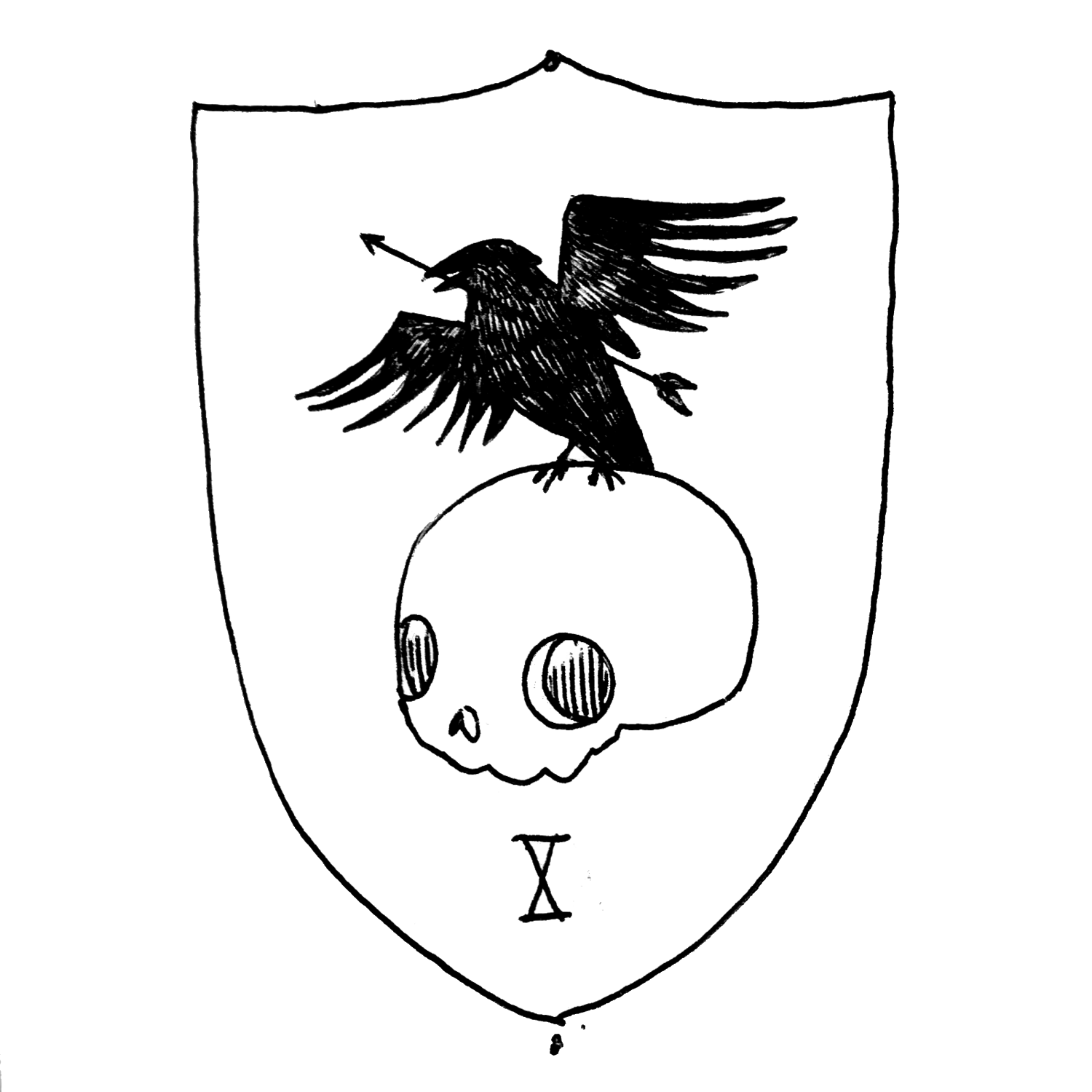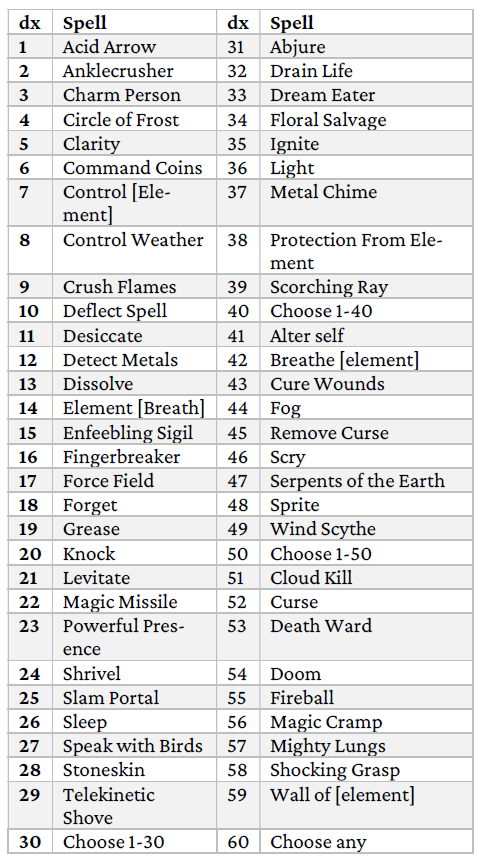Design Notes III: Wizards, GLOG, and 5e
Note: This post assumes you have familiarity with the GLOG wizard. See the Coins and Scrolls versions here.
Wizards are a difficult class to adjust. Magic has a way of solving almost any problem, and that tends to make Wizards the ultimate tool. Sure there are drawbacks: low hit points, one can only cast so many spells per day, and sometimes the DM won’t let you find a knock spell. But in the end, they can kill creatures better than the fighter and open locks better than the rogue. Only the secrets of healing are generally kept from the base wizard. A large part of wizard design is ensuring that they don’t outshine the entire party.
How GLOG handles wizards.
The GLOG wizard(s) handle this elegantly. Wizards are divided into subtypes (Garden, Orthodox, Necromancer, etc), which entirely determines their spell selections. Each wizard is limited to 8 of 12 possible spells, most of which are randomly rolled. Gone are the long lists of spells that take up… 25% of the (5e) Players Handbook. No longer is every wizard a generalist that can, with the right spells, overwhelm any challenge. Also as a bonus, all of this information is kept on a single page.
Magic Dice and spell casting.
Glog wizards are also limited by Magic Dice. Per each wizard template, a wizard gets a Magic Dice. These dice (always a d6) are used to power spells, whose effects are determined by the number of dice used, and the sum of the roll. Magic dice that roll a 1-3 are returned to the wizard’s pool, 4-6 are expended until the wizard gets a good night’s sleep. This is a de facto limit on a wizard’s power. Gone are the days of spell slots of varying levels, and spell preparation.
Here is an example spell and casting.
Fingerbreaker
R: 100' T: creature of [dice]x2 HD or less D: 0
The target of this spell must have fingers. You snap your fingers and your target's fingers crack, break, and bend. They take [sum] damage and must immediately Save or drop whatever they are holding. You can choose to have the target take no damage, but they get +2 to their Save.
So suppose our wizard, Galafrey, casts fingerbreaker on a creature while spending 2 Magic Dice. The rolls are 3 and 6. The spell could affect targets of 4hd or less and would do 9 damage. The wizard would get 1 Magic dice back, and the other would be expended.
Mishaps and Dooms
It turns out that pulling the energies of creation from the river of time (or whatever their magic source is) is dangerous. If a GLOG wizard rolls doubles on any of the Magic Dice rolled, there is a minor mishap. Nothing too bad, some damage or minor consequence (e.g. take 1d6 damage). If they roll triples then they take a step on their doom track. The first and second times are generally survivable, the third generally ends the wizard’s career. The specific doom is decided by the wizard’s subtype. For example, Orthodox wizards lose their connection to magic while Necromancer’s final doom raises approximately 3d20 undead that want to kill them.
We have talked about what the GLOG wizard does, and what makes it successful. The question is: how do we mash all of this together to create a wizard that feels more like a generic 5e wizard?
Making Wizards Worse (and more like D&D)
I hate to ruin the elegance of wizard types, but I want this iteration of the wizard to be closer to what is in 5e: which is the generic wizard. No templates and not limited to a book of 12 potential spells. I think most of the other rules from the GLOG apply. I don’t want to use spell slots so hopefully the pool of Magic Dice should be limited enough. The Wizard can cast any spell in their book as long as they have dice in their Magic Dice pool.
Mishaps can be made generic enough, so that isn’t a problem (in fact we could just use the Orthodox mishaps). I don’t know how I feel about minor mutations, but I’ll just keep it for now.
I love the variety for Dooms and I want to keep that system, so I set it up to just assign them when the first one occurs. Lore wise this can be handled by noting that wizards are stealing magic from someplace, they just don’t know where. When a Doom happens, the source of their magic notices. You are now a known element to the Queen of Spiders, and she will now enact her revenge. Done.
Let’s work on spell selection. D&D limits power to lower wizards by having spell levels, some spells are just too complex for low-level wizards. GLOG doesn’t have that, per se, but something close. When a wizard gets spells in GLOG, they roll a dice, and that dice grows with the number of wizard templates chosen. With the first template, a wizard gets to roll a 1d6 twice, and that expands to the d10 by the third template. Thus spells listed at higher numbers are inaccessible to low-level wizards. This creates a pseudo-spell level (it isn’t by accident that all fireball-style spells are inaccessible until the 4th template).
If you combine enough spells, you can just use a longer spell chart. Roll a 1d30 at the first template, 1d40 for the second, 1d50 for the third, and choose 4 for the final level and it works, probably.
From there, I added some tweaks. First, I added more sources of magic dice. Wizards add their intelligence modifier in Magic Dice and it’s possible to get one as a racial trait. An Elf with 4 wizard templates, an 18 in intelligence, and wearing robes could pull 9 magic dice. That might be too much, but it needs to be playtested. I would assume this could make dooms happen frequently, but it could make Wizards overpowered.
I also added the 5e ability Arcane recovery, which would give the wizard a chance to get a few dice back during the day. Again, this may be adding too much power, but we’ll have to see.
I also subtract a hit point for each level the wizard takes.
In the end, you get a template sheet that looks like this.
What do you think? Is this the way you would design a hybrid GLOG and 5e wizard? Let me know.


